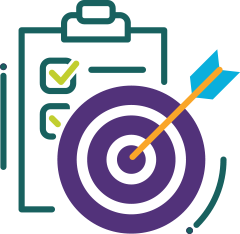* * * Bonus Material: Target Market Analysis Tool * * *
It’s not you, it’s them!
Seriously, if you are having trouble selling your product, it’s most likely because you’ve got the wrong audience, not the wrong product.
Not everyone is going to be your customer. And trying to position your product to fit their needs is a losing battle. Instead of trying to sell to everyone, you can reduce your effort and cost by defining your target market and adding it to your business plan. Then you’ll connect with the people who want to buy your product.
Let’s get started!
Psychographics and Demographics
To kick off our analysis, we’ll look at psychographics and demographics. Once you understand these, you can start narrowing down your audience and positively impact your sales.
Here’s a quick and simple definition:
Demographics – Identifies who your buyers are.
Psychographics – Identifies why they buy.

To go into more detail, demographic information includes gender, age, income, marital status and ethnicity. To get this information you can look at analytics or conduct surveys and interviews with your clients.
Psychographic information might be your audience’s perceived status in a group, hobbies, confidence, spending habits and values.
A fun way to understand your audience’s psychographic information is through social media. You can connect with your audience by hosting quizzes, polls and other interactive posts.

I think that focusing solely on demographics can be limiting as it leads people to the mistake of looking at their audience as a case study rather than a person you can connect with. According to recent data, if you create marketing materials that have meaningful connections with people there’s a 30% increase in click-through rates.*
When you define your target market in your business plan, use both types of information. And have a keen interest in psychographics.
Why Do You Buy?
Let’s flip this analysis over, and put you in the customer’s position.
Think about why you choose to do business with a particular company.
What is it about this vendor that appeals to you demographically?
Are they close and convenient? Do they speak the same language, belong to the same age group and social-economic level as you?
What’s the main reason you buy from them?

And more importantly, what is the emotional connection you have to this vendor? How do you FEEL about buying this particular product from this vendor?
What are you thinking? What are your expectations that you know will be met if you make this purchase?
The same reasons why you buy from a company, are the same reasons your customers will buy from you. Knowing why you buy is a great start to understanding why your customers buy. By doing this, you further your connection with your audience by getting on the same level as them.
You can quickly understand their choices and implement them to increase sales.
Why Does Your Audience Buy?
Now let’s switch back to you being the business owner.
To expertly define your target audience, you need to build on your personal experience as a customer.
Strengthen your analysis by asking why your target market buys. The better you know your customers the easier time you will have attracting and retaining them.
If you can respond to the following six questions with why a customer should choose your business, you are on the right track.

For a more in-depth questionnaire and customer profile, try this FREE target market analysis template.
Adjusting Your Systems
The final step in your analysis is adding your target market to your business plan.
How?
Adjust your systems! A system is the way something happens in your business.
You already have systems. Business owners can have systems written out in an operations manual. Or they have systems in their head that they intend to implement in their business. There are even systems that you are following that you are not even aware of that are getting you your current results.
Identify what systems need to change in order to incorporate your target market. This could be your marketing system, your service system or your pricing system.

This is the key step to success!
Lots of business owners know their target market. Yet, they don’t take the extra step to adjust their systems and business plan to include their ideal clients.
Here is one simple example.
Your target market is made up primarily of women over the age of 65. Chances are you will need to include in your sales system a more direct form of communication via the telephone or email vs sending a text or Snapchat message.
Your Quick Analysis Checklist
Did you analyze:
- Demographics
- Psychographics
- Your own experience as a customer
- The six key questions about what your customer thinks
And of course, remember to adjust your systems and business plan to respond to your target market.
Dig deep to understand why someone wants your product or service. Once you know why your audience buys, you’ll be restocking your inventory all the time.
Until next week, enjoy your Entrepreneurial Journey!

Sources
*Herskovitz, K. (2020, October). New research on advertising automation – think with google. Retrieved March 04, 2021, from https://www.thinkwithgoogle.com/intl/en-ca/consumer-insights/consumer-trends/new-research-on-advertising-automation/











